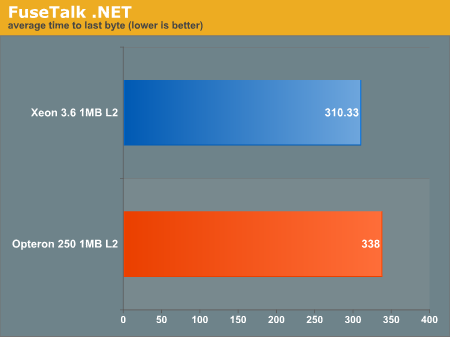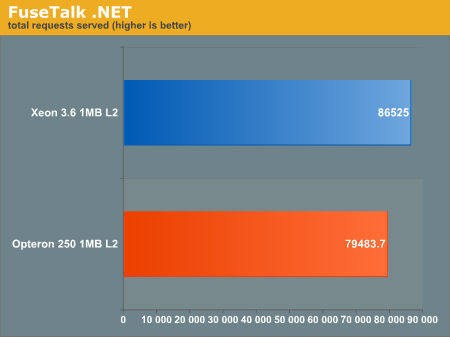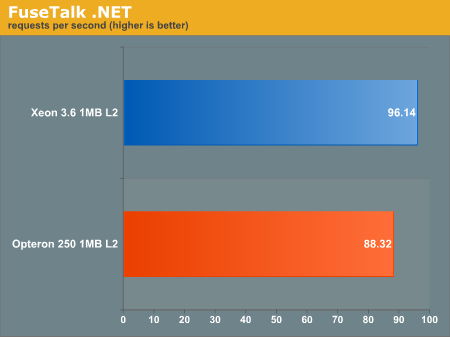Intel and AMD in a Web Application Shoot-out
by Jason Clark on October 18, 2004 12:05 AM EST- Posted in
- IT Computing
Microsoft .NET
This was probably the most interesting test out of the bunch, as there was a recognizable difference in the two architectures. Our .NET test was run on the recently released FuseTalk .NET collaboration application.The .NET platform is the new framework for building Windows-based and web-based applications from Microsoft. It not only replaces the older ASP platform, but introduces some up-to-date languages that run on the Common Language Runtime, which is the backbone of .NET. The three main languages used with .NET are: C# (similar to C++), VB.NET (somewhat similar to VB), and J# (fairly close to JAVA). Whatever language in which you write your code, it is compiled into an intermediate language, CIL (Common Intermediate Language). It is then managed and executed by the CLR (Common Language Runtime).
As you can see from the test results below, the Xeon managed to take the lead by approximately 8%. Why? Well, the one interesting piece of information that the .NET JIT (Just in Time) compiler takes into account during the compilation to native code is CPU architecture. According to a Microsoft MSDN article published by Allan McNaughton from Intel, the .NET JIT compiler takes CPU architecture into account during the last phase of compilation to native code. Specifically, during compilation, the JIT will detect Intel processors and produce code that takes advantage of Intel NetBurstTM and Hyper-Threading technology. With version 1.1 of the JIT compiler, Intel's Streaming SIMD Extensions 2 can also be a factor. At the time of publication, no information regarding any performance enhancing optimizations that occur for the AMD Opteron were found.













48 Comments
View All Comments
Jason Clark - Monday, October 18, 2004 - link
To all those looking for windows 64 bit numbers, we've actually already been testing. Lets just say that the builds we had were a bit too early for benchmarking with. We are continually monitoring the 64 builds, as soon as we have something we can work with we'll do an article.Jason Clark - Monday, October 18, 2004 - link
#15, we're looking at doing workstation, just takes time to come up with real meaningful tests.Regs - Monday, October 18, 2004 - link
All these dual cores on Web Based Applications! Why not have a workstation section?Jason Clark - Monday, October 18, 2004 - link
#7, since the I/O usage was barely 2% throughout the tests, why would you want a different drive? I/O should have no impact on most web applications unless in special cases the app is designed to use I/O for a purpose. Most any web application server out there is going to cache heavily. Anandtech has used IDE drives in our web servers for years, no issues and would perform no different than a Ultra 320 scsi drive.compudog - Monday, October 18, 2004 - link
Great work Jason. All you fanboys should READ the article. The big difference on the .Net platform is because of CPU optimizations, not as a result of CPU deficiencies. When/If MS writes optimized code for .NET on K8 the tests would likely be within the 2.5% deviation.AMD=Intel
ajuez - Monday, October 18, 2004 - link
Can you use the Windows 2003 Server 64 bit Edition on both plataforms?http://www.microsoft.com/windowsserver2003/64bit/x...
It could be interesting for future performance!
Thanks and sorry about my english
mikidutzaa - Monday, October 18, 2004 - link
Great article. I would LOVE to see the same benchmarks in Linux 32bit AND 64bit!If possible, maybe include some lower priced processors (say a 246 & 3.2).
Fluff - Monday, October 18, 2004 - link
Hmm this version of Server 2003 is not NUMA aware. How would this affect the results?Tides - Monday, October 18, 2004 - link
ah yes, another article that shows very little yet spreads a lot of opinion.why not just say, "we ran 3 programs, opteron won 2 of the 3 tests, but as you can see by our non biased views, the intel system owns the amd system."gimpsoft - Monday, October 18, 2004 - link